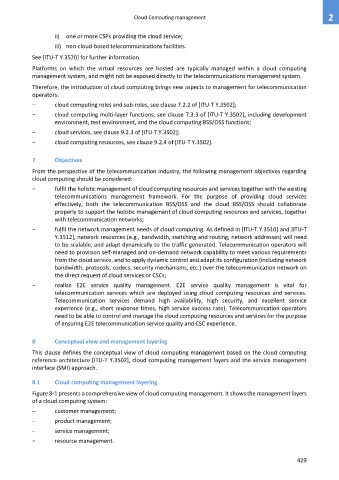Page 437 - Cloud computing: From paradigm to operation
P. 437
Cloud Computing management 2
ii) one or more CSPs providing the cloud service;
iii) non-cloud-based telecommunications facilities.
See [ITU-T Y.3520] for further information.
Platforms on which the virtual resources are hosted are typically managed within a cloud computing
management system, and might not be exposed directly to the telecommunications management system.
Therefore, the introduction of cloud computing brings new aspects to management for telecommunication
operators:
− cloud computing roles and sub-roles, see clause 7.2.2 of [ITU-T Y.3502];
− cloud computing multi-layer functions, see clause 7.3.3 of [ITU-T Y.3502], including development
environment, test environment, and the cloud computing BSS/OSS functions;
− cloud services, see clause 9.2.3 of [ITU-T Y.3502];
− cloud computing resources, see clause 9.2.4 of [ITU-T Y.3502].
7 Objectives
From the perspective of the telecommunication industry, the following management objectives regarding
cloud computing should be considered:
− fulfil the holistic management of cloud computing resources and services together with the existing
telecommunications management framework. For the purpose of providing cloud services
effectively, both the telecommunication BSS/OSS and the cloud BSS/OSS should collaborate
properly to support the holistic management of cloud computing resources and services, together
with telecommunication networks;
− fulfil the network management needs of cloud computing. As defined in [ITU-T Y.3510] and [ITU-T
Y.3512], network resources (e.g., bandwidth, switching and routing, network addresses) will need
to be scalable, and adapt dynamically to the traffic generated. Telecommunication operators will
need to provision self-managed and on-demand network capability to meet various requirements
from the cloud service, and to apply dynamic control and adapt its configuration (including network
bandwidth, protocols, codecs, security mechanisms, etc.) over the telecommunication network on
the direct request of cloud services or CSCs;
− realize E2E service quality management. E2E service quality management is vital for
telecommunication services which are deployed using cloud computing resources and services.
Telecommunication services demand high availability, high security, and excellent service
experience (e.g., short response times, high service success rate). Telecommunication operators
need to be able to control and manage the cloud computing resources and services for the purpose
of ensuring E2E telecommunication service quality and CSC experience.
8 Conceptual view and management layering
This clause defines the conceptual view of cloud computing management based on the cloud computing
reference architecture [ITU-T Y.3502], cloud computing management layers and the service management
interface (SMI) approach.
8.1 Cloud computing management layering
Figure 8-1 presents a comprehensive view of cloud computing management. It shows the management layers
of a cloud computing system:
− customer management;
− product management;
− service management;
− resource management.
429

